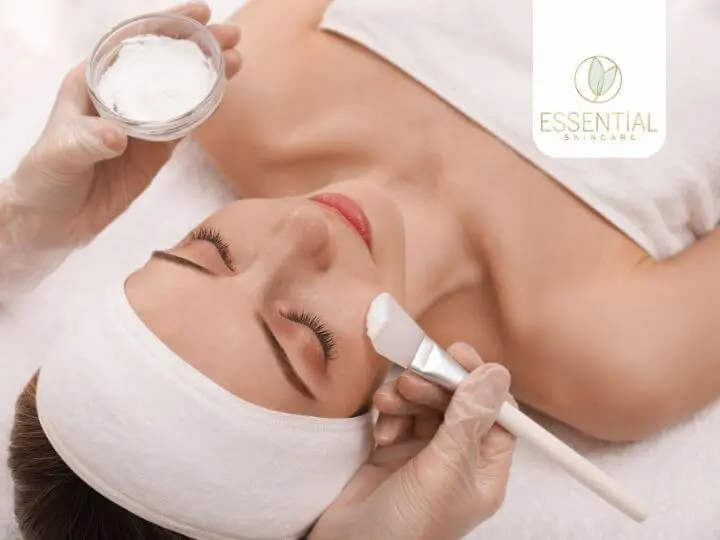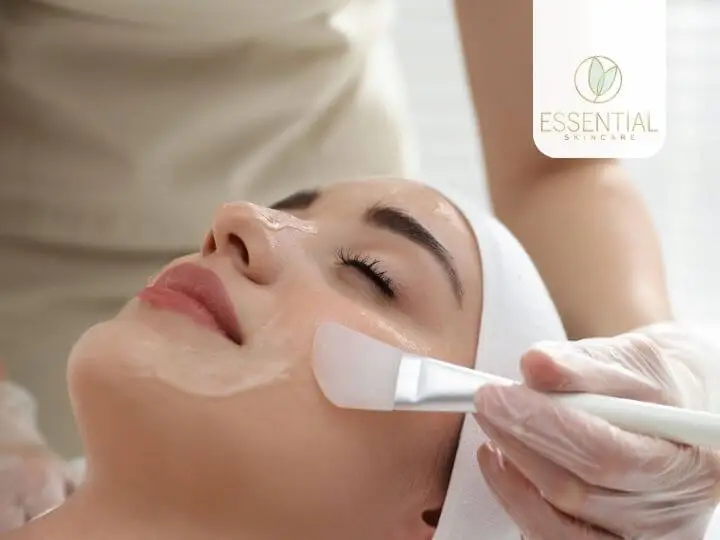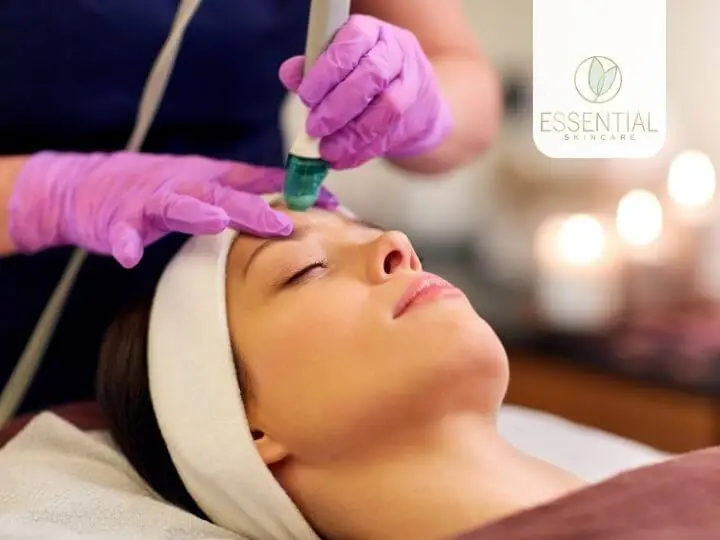Lactic acid, a popular component in skincare products, acts as a wonder worker to enhance your skin’s health. Deriving from the alpha hydroxy acid (AHA) family, it aids in refining skin texture while also addressing the issue of hyperpigmentation. Contrary to some beliefs, rather than causing dryness, lactic acid ensures hydration, promoting cell turnover for refreshed and rejuvenated skin. To experience optimal results from this ingredient, turn your attention towards our range of essential skincare products enriched with lactic acid. This discovery is just the touchpoint. Essential Skincare specializes in chemical peels, offering a transformative approach to achieving vibrant, healthy skin through their expertly formulated treatments.
Lactic acid is an alpha hydroxy acid (AHA) derived from milk that offers numerous benefits for the skin. It helps to exfoliate, hydrate, and improve skin texture, making it a popular ingredient in many skincare products and chemical peels.
Exploring Lactic Acid in Skincare
Lactic acid has become increasingly popular in the skincare world due to its impressive exfoliating and hydrating properties. As an alpha hydroxy acid (AHA), it offers numerous benefits for the skin. Let’s take a closer look at why lactic acid is making waves in the skincare industry.
First and foremost, lactic acid is valued for its exfoliating properties, which help improve the skin’s overall texture. By removing dead skin cells, lactic acid promotes cell turnover, leaving the skin feeling smoother and looking more radiant. It’s like a gentle scrub that uncovers the fresh, new skin underneath. This ability to encourage cell turnover can be especially beneficial for those dealing with dull or lackluster complexions.
Addressing Hyperpigmentation
Furthermore, lactic acid has shown promise in addressing hyperpigmentation concerns. Whether it’s dealing with age spots, sun spots, or general uneven skin tone, lactic acid can help fade these areas over time, leading to a more even complexion. For those seeking to combat hyperpigmentation, incorporating lactic acid into their skincare routine might prove to be a valuable addition.
Promoting Skin Hydration
In addition to its exfoliating prowess, lactic acid is known for its hydrating properties. Unlike some other exfoliants that can leave the skin feeling dry, lactic acid helps retain moisture while gently sloughing away dead skin cells. This hydration factor makes it a sought-after ingredient for those with dry or dehydrated skin.
When your skin feels dry or tight after using certain products, it could be due to dehydration caused by harsh exfoliation. With lactic acid, you get exfoliation with added hydration—a win-win!
These qualities make products such as lactic acid-infused moisturizers and serums particularly attractive options for individuals looking to address multiple skin concerns simultaneously.
Having covered some key benefits of lactic acid in skincare, let’s now uncover how this versatile ingredient can be effectively harnessed to achieve healthy and radiant skin.
The Influential Role of Lactic Acid
In the realm of skincare, lactic acid assumes a crucial role. Let’s delve into its function and understand why it’s an indispensable component in skincare products.
Exfoliation
Lactic acid is renowned for its gentle exfoliating properties. Unlike harsher chemical exfoliants, lactic acid delicately removes dead skin cells, promoting a smoother complexion and enhancing the skin’s natural radiance. This process encourages the turnover of skin cells, helping to reveal newer and healthier skin underneath.
The action of lactic acid resembles a gentle polishing that leaves your skin feeling soft and looking rejuvenated. By targeting the outer layer of the skin, lactic acid effectively improves the texture, leaving you with a revitalized and radiant glow. Its ability to exfoliate without causing irritation makes it an ideal choice for individuals with sensitive skin who may be hesitant to use harsher exfoliants.
Hydration
In addition to its exfoliating prowess, lactic acid has another compelling attribute: its hydrating capabilities. This alpha hydroxy acid has the unique ability to attract and retain moisture, making it an effective ingredient for maintaining skin hydration. By bolstering the skin’s natural barrier function, lactic acid assists in preventing water loss and ensures that your skin remains supple and well-nourished.
This dual-action approach – exfoliation paired with hydration – sets lactic acid apart as a multifaceted skincare asset. Not only does it help slough off dead skin cells, but it also works to keep your skin adequately moisturized, striking a delicate balance that promotes a healthy and glowing complexion.
Anti-Aging
The anti-aging potential of lactic acid should not be overlooked. Its role in reducing the appearance of fine lines and wrinkles is tied to its collagen-stimulating properties. As we age, our skin’s collagen production declines, leading to the development of fine lines and loss of firmness.
By promoting collagen production, lactic acid aids in plumping the skin, diminishing the visibility of fine lines and wrinkles. This gradual renewal process contributes to a smoother and more youthful complexion. The gentle yet effective nature of lactic acid makes it an appealing choice for those seeking anti-aging solutions without resorting to harsh treatments.
Brightening
Addressing skincare concerns such as dark spots, dullness, and uneven skin tone is a feat at which lactic acid excels. Through its exfoliating properties and promotion of cell turnover, lactic acid helps in diminishing discoloration and unveiling a brighter complexion.
It combats hyperpigmentation by targeting the accumulation of melanin, which is responsible for dark spots and uneven tone. This brightening effect leads to a more even complexion, offering a welcome boost for those seeking to achieve a radiant glow.
In essence, lactic acid stands out as an influential figure in skincare due to its multifaceted benefits—exfoliation for smoother skin texture, hydration for nourishment, anti-aging support through collagen stimulation, and brightening effects that enhance overall complexion.
As we continue our exploration into the world of skincare, let’s now shift our focus to uncovering the myriad benefits that lactic acid brings to the table.

The Multifaceted Benefits of Lactic Acid in Skincare
Lactic acid may sound like it comes from a lab, but it’s actually a gentle helper in your skincare routine. Let’s uncover some of the amazing ways it can benefit your skin.
Gentle Exfoliation
Lactic acid stands apart from other Alpha Hydroxy Acids (AHAs) due to its milder exfoliating properties. Unlike glycolic acid, lactic acid is better suited for individuals with sensitive skin. It works by delicately lifting away dead skin cells, leaving behind smoother and brighter skin without causing irritation.
Improved Texture
Using lactic acid regularly can lead to a transformation in your skin’s texture. It’s like discovering a secret weapon that smooths out rough patches and leaves your skin feeling softer. The regular use of lactic acid can reduce the overall roughness of your skin, giving it a more even and velvety appearance.
In essence, lactic acid helps to renew the surface of the skin. By encouraging the shedding of dead skin cells, it promotes a more refined and uniform texture. Just imagine running your hand across your face and feeling not only smoothness but also a refreshing radiance—lactic acid can make that happen.
Skin Rejuvenation
Lactic acid has got you covered when it comes to achieving that youthful glow. Its gentle exfoliating action helps revitalize the skin’s appearance, leading to a more youthful and radiant complexion. By removing the dull, tired outer layer of skin, lactic acid reveals fresher, healthier-looking skin beneath.
It’s like a reset button for your complexion. Day by day, as you incorporate lactic acid into your routine, you’ll notice your skin looking brighter and more vibrant. After all, who wouldn’t want to unveil their best skin?
Enhanced Absorption
Lactic acid isn’t just an overachiever by itself; it also improves the performance of other skincare products. By gently exfoliating the skin’s surface, lactic acid creates a clean slate for better absorption of additional skincare ingredients, maximizing their effectiveness.
Think of it as creating a clear pathway for other beneficial ingredients to penetrate deeply into the skin. This means that after using products with lactic acid, subsequent skincare treatments such as moisturizers or serums will be able to work more effectively, providing enhanced results.
So, not only does lactic acid work wonders on its own, but it also acts as an empowering force for the rest of your skincare routine—talk about being a team player!
Conclusion
Lactic acid truly is a multi-talented skincare ingredient. From providing gentle exfoliation suitable for sensitive skin to enhancing overall texture and improving product absorption, its benefits are indeed multifaceted. It’s no wonder skincare enthusiasts continue to sing praises about this valuable addition to their daily routines!
Now that we’ve uncovered the incredible benefits of lactic acid in skincare, let’s turn our attention to understanding its potential side effects in our pursuit of flawless skin.
Understanding the Side Effects of Lactic Acid
Lactic acid is generally well-tolerated by most skin types, but like any skincare ingredient, it’s essential to be aware of potential side effects. One of the common side effects of topical lactic acid includes a mild sensation like burning, tingling, or stinging, which may occur particularly at higher concentrations due to lactic acid being an alpha hydroxy acid (AHA), which can be quite potent at higher strengths.
When using lactic acid products for the first time, it’s important to perform a patch test on a small area of your skin to check for any adverse reactions. This allows you to assess your skin’s sensitivity and determine the appropriate frequency and concentration of lactic acid suitable for your skin type.
It is important to note that while mild tingling or stinging may occur initially, it should not persist for an extended period. If you experience persistent discomfort or if the sensation worsens with continued use, it is advisable to discontinue use and consult a dermatologist.
Furthermore, lactic acid can increase the skin’s susceptibility to the sun. This means that when using products containing lactic acid, it becomes even more crucial to diligently apply broad-spectrum sunscreen daily as part of your skincare routine. By doing so, you’re effectively safeguarding your skin from potential UV damage and ensuring that the benefits of lactic acid aren’t overridden by sun-induced skin issues.
For instance, imagine lactic acid as an effective yet delicate ingredient that needs to be protected from harmful UV rays. Just like how you protect a valuable item by keeping it out of direct sunlight, applying sunscreen becomes its protective shield, preserving the integrity and benefits of the lactic acid on your skin.
In this way, using sunscreen can be seen as an insurance policy for reaping the rewards of lactic acid without risking harm from sun damage.
Now let’s explore the potential issue of over-exfoliation due to excessive use of lactic acid in skincare.
Guidelines for Using Lactic Acid Skincare Products
When introducing lactic acid into your skincare routine, it’s important to take precautionary steps to ensure that your skin adapts well to this powerful ingredient. Here are some essential guidelines to keep in mind:
Patch Testing
Performing a patch test is like a safety check for your skin. Before incorporating any new lactic acid product into your routine, perform a patch test to assess how your skin reacts. Apply a small amount of the product to a discreet area of your skin, such as behind your ear or on your inner forearm. Wait 24-48 hours to see if there’s any reaction—this will help you determine if the product is suitable for your skin type and sensitivity. Remember, everyone’s skin is unique, so what works for someone else may not work for you.
Gradual Introduction
Lactic acid can be quite potent, especially in higher concentrations. It’s best to ease into it gradually. Start with products containing lower concentrations of lactic acid, such as a gentle cleanser containing 5% lactic acid or a serum with 10% lactic acid. Allow your skin time to acclimate before moving on to higher concentrations. This gradual introduction helps minimize the likelihood of irritation or adverse reactions while giving your skin the opportunity to adjust to the exfoliating effects of lactic acid.
Sun Protection
Whether you’re using lactic acid or any other exfoliating product, always make sunscreen with a high SPF (30 or higher) a non-negotiable part of your daily routine. Lactic acid can make your skin more sensitive to sunlight, and without proper protection, you risk damaging freshly exfoliated skin. The last thing you want after diligently caring for your skin is to undo all that hard work by exposing it to harmful UV rays.
For instance, think of using sunscreen as wrapping up in a cozy blanket after stepping out of a refreshing shower—it’s an essential final step in protecting your newly revitalized skin.
Following these guidelines will help you integrate lactic acid into your skincare regimen effectively and safely, ensuring that you reap the full benefits without experiencing any unnecessary side effects.
Skin Conditions and the Role of Lactic Acid
Lactic acid isn’t just a one-trick pony; it’s actually a multitasker when it comes to improving various skin conditions. Let’s discuss some common skin concerns and how lactic acid assists in addressing them.
Acne-prone Skin
Lactic acid’s exfoliating properties are especially beneficial for those with acne-prone skin. Here’s how: When dead skin cells build up on the skin’s surface, they can clog pores and lead to acne breakouts. Lactic acid helps in reducing this buildup of dead skin cells, unclogging pores, and preventing acne from forming. By keeping the pores clear, lactic acid contributes to clearer and healthier-looking skin over time.
In addition to its exfoliating benefits, lactic acid also possesses antimicrobial properties that can be particularly helpful in controlling acne-causing bacteria. By inhibiting the growth of these bacteria, it aids in reducing the occurrence of new blemishes while promoting an overall improvement in skin texture.
Hyperpigmentation
Hyperpigmentation, such as dark spots or uneven skin tone, is a common concern for many individuals. Lactic acid works wonders in addressing this issue by aiding in fading dark spots and hyperpigmentation. How does it do this? Lactic acid promotes gentle exfoliation, which stimulates cell turnover and renewal. As new, fresh skin cells come to the surface, they can contribute to a more even complexion over time, helping to reduce the appearance of dark spots and promoting a smoother skin tone.
Consistent use of lactic acid in skincare routines is key when targeting hyperpigmentation. Over time, the continuous exfoliation and renewal process facilitated by lactic acid contribute to gradual improvements in skin tone and clarity.
Sensitive Skin
For those with sensitive skin, finding effective skincare solutions without causing irritation can be quite a challenge. However, lactic acid comes to the rescue even for individuals with sensitive skin. What makes it suitable for sensitive skin? Well, certain formulations of lactic acid are specifically designed to provide the benefits of exfoliation and hydration without causing irritation. This means that those with sensitive skin can enjoy the advantages of lactic acid without having to worry about potential redness or discomfort.
Moreover, compared to other alpha hydroxy acids (AHAs) like glycolic acid, lactic acid is known for being gentler on the skin due to its larger molecular size. This allows it to exfoliate more slowly, making it a favorable choice for individuals with sensitive skin who may experience irritation from other types of AHAs.
Sensitive-skin-friendly formulations containing lactic acid play a pivotal role in providing gentle exfoliation while maintaining the natural moisture balance of the skin, ultimately catering to the unique needs of sensitive skin types.
Understanding how lactic acid addresses specific skin concerns sheds light on its versatility and efficacy as a skincare ingredient. Now that we’ve explored its benefits for various skin conditions, let’s delve deeper into how lactic acid impacts the overall texture and appearance of the skin.
To explore further or try out skincare products containing lactic acid for yourself, visit us at Essential Skincare. Call us at: (419) 908-9301.












